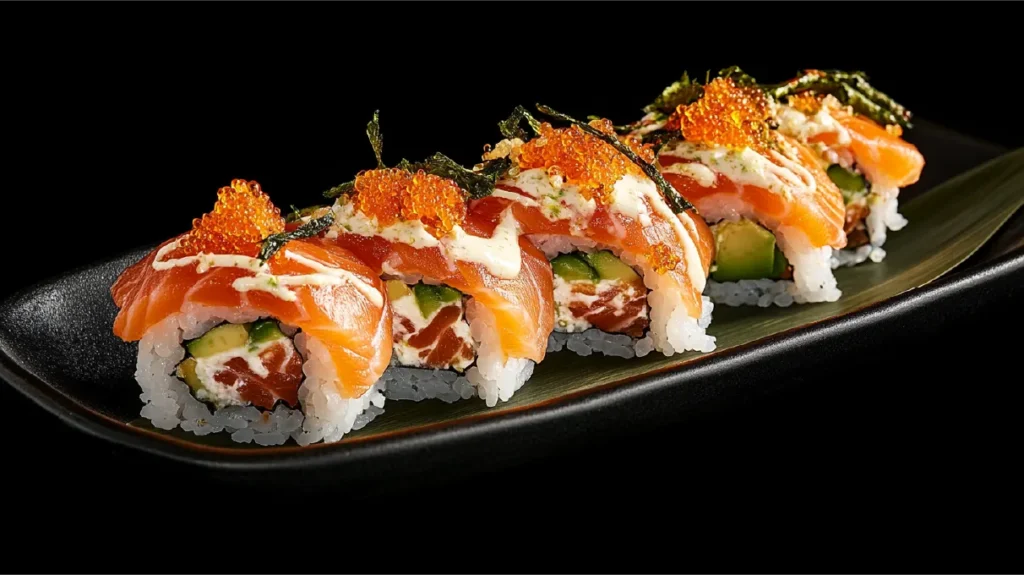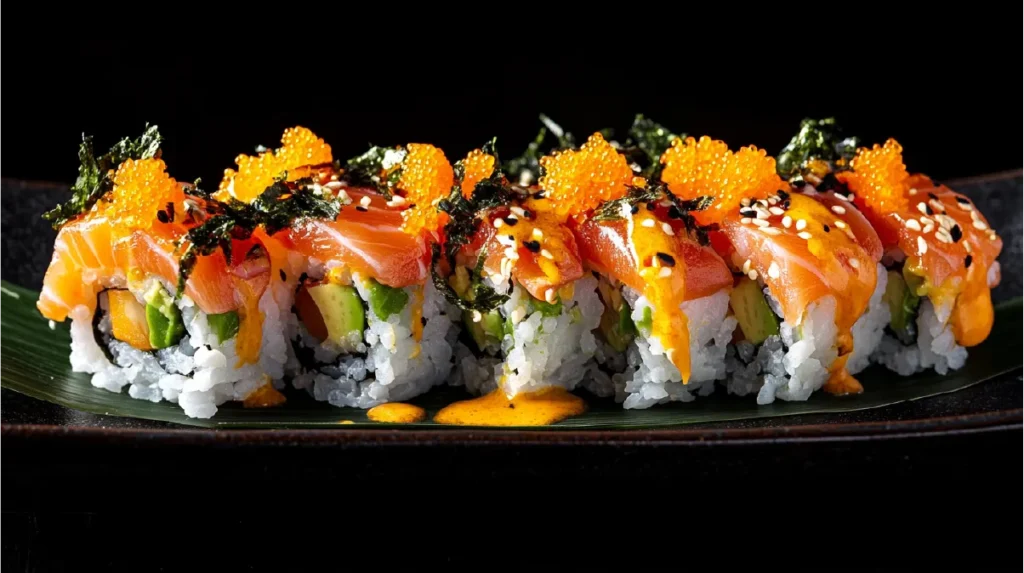I’ve always been fascinated by sushi-making. The clean flavors and precision needed to make these delicate bites are captivating. The salmon roll is my favorite, with its silky fish and sweet, vinegary rice.
In this guide, I’ll share secrets for making perfect salmon rolls at home. Whether you’re new to sushi or a seasoned chef, you’ll learn to make restaurant-quality rolls. We’ll cover everything from choosing fresh ingredients to mastering the roll.
Let’s start making salmon rolls! With practice and the right tips, you’ll impress your loved ones. Get ready to make your home dining more exciting and bring Japan’s flavors to your table.
Essential Tools and Ingredients for Making Sushi at Home
Making seafood rolls, nigiri, and maki rolls at home is fun. You’ll need the right tools and ingredients to start. Let’s look at what you need for your sushi-making adventure.
Quality Rice and Nori Selection
The key to great sushi is the rice. Choose short-grain Japanese-style sushi rice for its sticky texture. Pair it with high-quality nori sheets, the seaweed that wraps the rolls.
Required Equipment and Utensils
- Bamboo sushi mat: This tool, costing about $7, helps roll sushi tightly and evenly.
- Sharp sushi knife: While optional, a sushi knife makes clean, uniform cuts.
- Rice paddle: Use this to mix and spread sushi rice for perfect rolls.
Choosing the Right Fish Grade
For the main ingredient, choose sashimi-grade salmon or tuna. These fish offer the best taste and safety when raw. Beginners might prefer cooked or smoked seafood too.
With the right tools and ingredients, you’re ready to make delicious homemade sushi. Next, we’ll explore how to prepare sushi rice.

Understanding Sushi Rice Preparation
Learning to make sushi rice is key to making tasty California rolls and rice rolls at home. Short-grain white rice is best for sushi because it’s stickier. This makes it easier to shape and keeps the rolls together.
To get the rice just right, use a 1:1 ratio of rice to water. Cook the rice, then mix in rice vinegar, salt, and sugar. This step is important because it gives the rice its unique sweet and tangy taste.
“Sushi rice, traditionally Japanese short-grain rice, has a stickier consistency compared to regular rice like Jasmine rice, which is a long-grain rice with a lighter texture.”
Don’t over-mix the seasoned rice. This can make it mushy. Instead, gently fold the rice to spread the flavors evenly. Adding toasted sesame seeds can also add flavor and texture.
By following these steps, you’ll be on your way to making great sushi rice. This is the base for your homemade California rolls and rice rolls. With the right technique, you can make sushi that tastes like it came from a restaurant, right in your own kitchen.
The Art of Perfect Salmon Roll Assembly
Making the perfect salmon roll at home is all about technique and precision. Start by spreading sushi rice evenly on the nori sheet, leaving a 2-centimeter strip at the top. This helps the roll stay tight and secure.
Create a shallow “valley” in the rice for your salmon and other fillings. This makes it easy to place them neatly.
Proper Rice Spreading Technique
Use damp fingers to press the rice onto the nori. Make sure it’s spread evenly. Don’t press too hard, as this can make the roll dense and heavy.
Getting the rice right is crucial for a light and fluffy roll.
Ingredient Placement and Portions
Think about the size and shape of your fillings. Cut the salmon into thin, diagonal slices for a nice look. This also helps distribute it evenly in the roll.
For ingredients like avocado or cucumber, cut them into strips no thicker than 1/4 inch (1 cm). This ensures they fit well in the roll.
Rolling Techniques with Bamboo Mat
Use a bamboo sushi mat to roll the nori, rice, and fillings into a tight cylinder. Moisten the exposed nori edge with water to seal the roll.
With a sharp knife, cut the roll into bite-sized pieces. Wipe the blade clean between cuts for a clean finish.
Mastering these techniques lets you make authentic salmon rolls at home. The key is to practice and have fun. Explore the flavors and textures of Japanese cuisine as you become your own sushi chef.
Selecting and Preparing Fresh Salmon
For the best seafood rolls, high-quality, sushi-grade salmon is key. Look for salmon that is fresh, firm, and has no discoloration or bad smells. Raw fish like salmon is the main attraction in seafood rolls, so picking the freshest and safest is crucial.
To prepare the salmon, cut it into thin, even slices about 1 cm thick. This ensures each piece of seafood rolls has the right amount of salmon. You can also halve or cut the slices diagonally for a uniform look. If you’re new or can’t find sushi-grade fish, try using smoked salmon.
It’s important to handle and store the raw salmon properly. Clean and sanitize your work surfaces before and after handling the fish. Disinfect your knives and wash your hands with antibacterial soap to avoid cross-contamination. Keep the salmon chilled and eat it within 1-2 days for the best taste.
“Selecting the right salmon is the foundation for crafting delicious, authentic-tasting seafood rolls at home.”
By following these tips, you’ll make sushi rolls that are as good as those from your favorite Japanese restaurant. The secret to success is using the highest-quality raw fish and handling it carefully.
- Choose sushi-grade or sashimi-grade salmon for the freshest, safest option.
- Cut the salmon into thin, even slices about 1 cm thick for consistent portions.
- Sanitize your work area and utensils to prevent cross-contamination.
- Store the prepared salmon in the refrigerator and consume within 1-2 days.
By following these simple steps, you can select and prepare fresh salmon that will make your homemade seafood rolls even better. Enjoy the amazing flavors and textures of your sushi creations!
Step-by-Step Guide to Rolling Your First Salmon Roll
Sushi making might look hard, but it’s easy with the right steps. You can make tasty maki rolls at home. Let’s learn how to roll your first salmon sushi roll.
Nori Positioning and Rice Layer
Begin by putting a sheet of nori, shiny side down, on your bamboo sushi mat. Spread a thin layer of sushi rice over the nori. Make sure to leave about an inch of nori uncovered at the top.
Adding Fillings and Toppings
- Put your favorite amount of sliced salmon in the middle of the rice.
- Add fillings like avocado, cucumber, or cream cheese to make your maki roll special.
Sealing and Cutting Techniques
Use the bamboo mat to roll the nori tightly around the fillings. Press evenly as you roll. Wet the exposed nori edge with water to seal the roll. Cut the roll into 6-8 pieces with a sharp, damp knife for the classic Uramaki look.
With practice, you’ll be a sushi pro in no time! Success comes from good preparation. Set up your space well and use quality ingredients. Enjoy your homemade salmon maki rolls with loved ones.
Common Mistakes to Avoid When Making Sushi
Making sushi is all about the details and knowing the right techniques. As you start making sushi, watch out for common mistakes. These mistakes can ruin your sushi’s look and taste. By avoiding them, you’ll make sushi that looks great and tastes amazing.
One big mistake is using warm rice. Warm rice makes the seaweed wrapper soggy. So, spread the rice in a wide bowl and let it cool fast before adding vinegar.
- Don’t overstuff your sushi rolls. Too much filling makes them hard to roll and taste off-balance. Try to keep a good balance of rice, fish, and veggies.
- Make sure your knife is sharp and clean. A dull knife can tear the seaweed, making your sushi look bad. Sharpen your knife before you start.
- Don’t press the rice too hard on the seaweed. Pressing too hard makes the rice dense and chewy. This ruins the sushi’s light feel.
- Don’t skip the seasoning. The vinegar mix is key for the right taste. Seasoning the rice right is crucial for true Japanese flavor.
By avoiding these common mistakes, you’ll make sushi that looks and tastes great. With practice and attention to detail, you’ll soon be a pro at making sushi.
“Sushi is an art form, and the quality of the ingredients is paramount. Paying attention to the little details is what separates good sushi from great sushi.”
Traditional vs Modern Salmon Roll Variations
The salmon roll has changed a lot in sushi. It started simple but now includes new flavors. The classic version is loved for its pure taste. But now, we also have the California and Philadelphia rolls, which add new twists.
Classic Hosomaki Style
Hosomaki, or thin sushi rolls, are a big part of Japanese food. The traditional salmon hosomaki is simple. It has sushi rice, nori seaweed, and a thin slice of salmon. This lets the salmon’s sweetness and softness stand out.
Contemporary Fusion Options
Modern chefs love to try new things. California rolls add avocado, crab, and sometimes cream cheese. Maki rolls might have tempura-fried salmon or spicy mayonnaise. These changes make sushi exciting and different.
For those who don’t eat meat, there are great options. Rolls with cucumber, avocado, or carrots are tasty. They let people try different sushi styles and flavors, fitting many tastes and diets.
“Sushi is not just a dish, it’s an art form that celebrates the beauty and complexity of natural ingredients. From the traditional hosomaki to the modern fusion creations, the salmon roll continues to captivate sushi enthusiasts around the world.”
Essential Sauce and Condiment Pairings
Take your homemade sushi to the next level with the right sauces and condiments. From traditional Japanese flavors to new twists, the right mix can make your salmon rolls unforgettable.
Begin with the basics: soy sauce, wasabi, and pickled ginger. Shoyu, a Japanese soy sauce, combines saltiness with hints of fruit and vanilla. For a lighter touch, try Shiro soy sauce, which adds flavor without overpowering.
Try Ponzu, a zesty soy vinaigrette, for a sweet and citrusy kick. It’s great with both lean and fatty fish like salmon. Unagi sauce, with its sweet and savory mix, is perfect for sushi, grilled meats, and veggies.
- Shoyu: Classic Japanese soy sauce with a symphony of flavors
- Shiro: Delicate white soy sauce that elevates delicate ingredients
- Tamari: Gluten-free soy sauce with a robust umami punch
- Ponzu: Zesty soy vinaigrette with a touch of sweetness
- Unagi sauce: Sweet and savory fusion for versatile pairings
Wasabi adds a quick but intense heat to your sushi. For something new, try chili crisp or aji amarillo for a unique flavor.
Make your sushi stand out with homemade sauces and condiments. The Eel Sauce recipe makes up to 20 rolls with its sweet and savory taste. Dynamite Sauce adds a creamy, spicy flavor to 6 rolls. Try these and other sauces to find your favorite for homemade salmon rolls.
Ingredients
For the sushi rice:
2 cups short-grain sushi rice (uncooked)
2 1/4 cups water (for cooking)
2 tablespoons rice vinegar
1 tablespoon sugar
1/2 teaspoon salt
For the Rolls:
4 sheets nori (seaweed)
200 g sushi-grade salmon, sliced thinly
1/2 cup cucumber, julienned
1/2 avocado, sliced
For Serving (Optional):
Soy sauce (for dipping)
Wasabi (optional)
Pickled ginger (optional)
Execution
Rinse and Cook the Rice:
Wash 2 cups of sushi rice until the water runs clear, then cook in 2 1/4 cups of water for 15 minutes.
Season the Rice:
Mix 2 tablespoons rice vinegar, 1 tablespoon sugar, and 1/2 teaspoon salt, then gently fold it into the cooked rice.
Prepare the Salmon and Vegetables:
Slice 200 g of sushi-grade salmon thinly. Julienne 1/2 cup cucumber and slice 1/2 avocado into thin wedges.
Lay the Nori and Rice:
Place a sheet of nori on a bamboo mat and spread a thin layer of rice, leaving a 2 cm strip at the top.
Add the Fillings:
Arrange the salmon, cucumber, and avocado neatly in the center of the rice.
Roll the Sushi:
Roll the nori tightly using the bamboo mat, moistening the top edge with water to seal.
Slice the Roll:
Use a sharp, wet knife to cut the roll into 6-8 even pieces.
Serve:
Present the salmon rolls with soy sauce, wasabi, and pickled ginger on the side.
Additional tips
- Use Plastic Wrap: Place a sheet of plastic wrap over the bamboo mat to prevent sticking and make rolling easier.
- Chill Ingredients: Keep all ingredients cold until assembly to maintain freshness and make handling simpler.
- Don’t Overfill: Use moderate amounts of filling to ensure the rolls are easy to close and maintain their shape.
- Slice with Precision: Dip your knife in water before each cut for clean slices without tearing the nori.
- Experiment with Fillings: Try adding cream cheese, spicy mayo, or tempura shrimp for creative variations.
- Practice Rolling: Don’t worry if the first roll isn’t perfect; practice improves technique and consistency.
- Serve Immediately: Sushi tastes best fresh, so serve the rolls shortly after preparing them.
Conclusion
We’ve shown you how to make tasty salmon rolls at home. You learned about picking the best ingredients, making sushi rice, and rolling techniques. Now, you can make sushi as good as your favorite Japanese restaurant.
Making salmon rolls at home saves money and lets you try new things. Try different fillings and toppings to find what you like best. Always use fresh, high-quality ingredients and follow food safety rules.
Whether you’re new to cooking or love making sushi, making your own salmon rolls is fun. Dive into the Japanese cuisine world and show off your cooking skills. Enjoy your meal!




